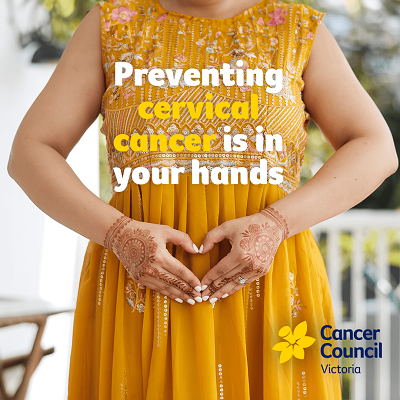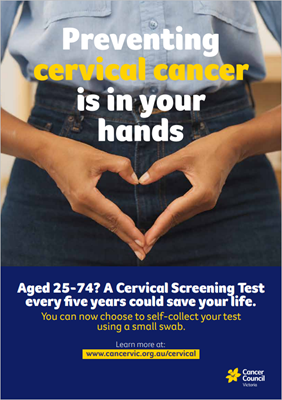Increasing cervical screening participation in your patients
Health professionals play an important role in the National Cervical Screening Program by sharing knowledge and increasing eligible patients' understanding and participation in the program.About cervical screening in Victoria
The National Cervical Screening Program commenced in Australia in 1991. Since the introduction of the program, Australia has seen a 50 per cent reduction in both cervical cancer incidence and mortality.
Under the National Cervical Screening Program, women and people with a cervix, who have ever been sexually active, are invited to do a Cervical Screening Test every five years between the ages of 25 and 74.
Cervical cancer is one of the most preventable cancers and can be successfully treated, if found early.
Despite this, recent Victorian estimates show that only 66% of eligible women and people with a cervix in Victoria are participating in the National Cervical Screening Program.1
In Victoria, some population groups face additional barriers to screening or treatment services and are disproportionally affected by cervical cancer. These groups include Aboriginal and/or Torres Strait Islander populations, those living regionally or remote, culturally and linguistically diverse communities, LGBTIQ+ populations and people living with a disability.
Universal access to self-collection
It's been three years since the National Cervical Screening Program was expanded to include self-collection as an option for the majority of people eligible for cervical screening.
Evidence has shown that self-collection is an acceptable option, including in under-screened or never screened populations, and can help to address many of the barriers experienced in accessing cervical screening by providing a more private, comfortable and less invasive option.
Self-collection can help remove significant barriers to cervical screening and increase participation rates, particularly in under screened and never screened populations.
It presents a critical opportunity to increase screening participation and protect more women and people with a cervix against this almost entirely preventable cancer.
How you can help
Help increase cervical screening participation rates in your patients by discussing the importance of the test, explaining the options for the test, and encouraging and supporting them to do the test if they are due or overdue.
It’s important that health professionals check if eligible patients are up to date with their cervical screening and reminding them if and when they are due. You can check your patients’ screening status on your clinic records or through the National Cervical Screening Register.
It’s also important for clinics to be ready to offer the self-collection option for those who want it and promote this option to their patients. You can:
- Upskill on self-collection.
- Check your patients' screening status and discuss cervical screening during an appointment.
- Learn about the barriers experienced by some under-screened groups.
- Ensure your practice is ready to offer self-collection.
- Make sure your patients are aware of the self-collection option, and let them know their choices for cervical screening.
- If you provide cervical screening services, add your clinic to Cancer Council Victoria’s Cervical Screening Directory.
If your patient can't get into a clinic, you can suggest they book a telehealth appointment and have the self-collect test sent to them.
Get your clinic self-collect ready
Self-collection can help remove significant barriers to cervical screening and increase participation rates, particularly in under screened and never screened populations.
As more patients become aware of this option and ask for it, make sure your clinic is ready.
Below are the steps to get your clinic set up:
- Talk to your pathology laboratory and:
a. Confirm that they can process self-collected vaginal samples, or
b. Confirm that they are able to send on the samples to a laboratory that can process self-collected vaginal samples, and
c. Confirm any collection, handling and transport requirements. - If your local pathology laboratory does not offer or support self-collection, you can contact an accredited laboratory directly to arrange for processing of the sample.
- Order the correct swabs and other consumables from your chosen pathology laboratory.
- Communicate these changes and processes to everyone in the practice team.
- Promote self-collection as an option to your patients. You can download and order resources to help with your discussions here.
- Direct patients to find out more about self-collection on the Cancer Council Victoria website at cancervic.org.au/selfcollection.
Find more education and support for self-collection
VCS pathology, a division of the Australian Centre for the Prevention of Cervical Cancer (ACPCC), offers self-collection education and support for healthcare professionals, regardless of the pathology division they use.
- Access a dedicated cervical screening and self-collection resource hub for healthcare providers at www.acpcc.org.au/practitioners/resource-hub
- Access webinars and accredited online courses at www.acpcc.org.au/practitioners/education
- Call VCS Pathology’s Clinical Advisory Service on (03) 9250 0309
- For more information, including education requests, contact education@acpcc.org.au
Add your clinic to Cancer Council Victoria’s Cervical Screening Directory
Cancer Council Victoria’s Cervical Screening Directory is a useful tool to help women and people with a cervix find a provider that suits their needs. Users can search for a provider by location, type of provider, gender, languages spoken, disability access and providers who are sexual assault or traditional cutting sensitive.
Help to protect more Victorian women and people with a cervix against cervical cancer by promoting cervical screening on your clinic channels.
Below you will find text and images for your clinic newsletters, website and social media pages that you can copy and paste and share with your audiences.
Key messages
- Cervical cancer is one of the most preventable and treatable cancers, if found early.
- Almost all cases of cervical cancer are caused by human papillomavirus (HPV), a very common virus spread through sexual activity.
- A Cervical Screening Test (which replaced the Pap test in 2017) looks for human papillomavirus (HPV).
- Finding HPV early gives you the best protection against cervical cancer.
- If you are a woman or person with a cervix aged 25 to 74, you need to do a Cervical Screening Test every five years, even if you don’t have any symptoms.
- You can now choose to self-collect your next Cervical Screening Test using a small swab.
- Self-collection is done in a private space at a healthcare clinic, usually behind a curtain or in the bathroom.
- Self-collection is quick, easy, private and just as accurate at detecting HPV as a test done by a doctor or nurse.
- If you can't get into a clinic, you may be able to book a telehealth appointment and have a self-collected test kit sent to you. Speak to your healthcare provider about this option.
- Preventing cervical cancer is in your hands.
- Find out more about cervical screening and the self-collection option at cancervic.org.au/cervical.
Articles for newsletters/websites
Article 1
Protect yourself against cervical cancer, book in for your cervical screening
Cervical cancer is one of the most preventable and treatable cancers, if found early.
Almost all cases of cervical cancer are caused by human papillomavirus (HPV), a very common sexually transmitted infection.
A Cervical Screening Test looks for the presence of HPV (human papillomavirus). Finding HPV early is your best protection against developing cervical cancer.
If you are a women or person with a cervix aged 25 to 74, who has ever had sexual contact, you need to do a Cervical Screening Test every five years, even if you don’t have any symptoms.
Now, you have the option to self-collect your test, using a small swab. It’s quick, easy, private and just as accurate at detecting HPV as a test done by a doctor or nurse.
If you’re due, book in and speak to one of our practitioners about your cervical screening options, including self-collection.
If you can't get into a clinic, you may be able to book a telehealth appointment and have a self-collected test kit sent to you. Speak to your healthcare provider about this option.
Preventing cervical cancer is in your hands!
Find out more about cervical screening at cancervic.org.au/cervical.
Article 2
Self-collection is available for cervical screening
If you’re a woman or person with a cervix, aged 25 to 74, a Cervical Screening Test every five years is your best protection against cervical cancer.
Now, you can choose how you do your test – you can have a doctor or nurse do the test, or you can self-collect your test using a small swab!
A self-collected test is done in a private space at the clinic, such as in the bathroom or behind a screen. You may also be able to take the test home to take the sample and return it to the clinic for testing.
It’s quick, easy, private and just as accurate as a test done by a doctor or nurse.
If you’re due for a Cervical Screening Test, book in and speak to one of our practitioners about your cervical screening options, including self-collection.
If you can’t get into a clinic, you may be able to book a telehealth appointment and have a self-collected test kit sent to you. Speak to your healthcare provider about this option.
Find out more about self-collection and cervical screening at cancervic.org.au/cervical
Social media posts
Download the images below and help to ensure all women and people with a cervix are aware of the importance of regular cervical screening and know their testing options.
Don’t forget to tag us at @cancervic so that we can see your posts!
Post 1
Are you due for your Cervical Screening Test?
Cervical cancer is one of the most preventable and treatable cancers, if found early.
If you’re aged 25 to 74, a Cervical Screening Test every five years is the best way you can protect yourself against cervical cancer.
If you can’t get into a clinic, you may be able to book a telehealth appointment and have a self-collected test kit sent to you. Speak to your healthcare provider about this option.
Book in with one of our practitioners today!
Find out more on the @cancervic website: cancervic.org.au/cervical
Post 2
Cervical cancer is one of the most preventable and treatable cancers, if found early!
Almost all cervical cancers are caused by a common virus called HPV (human papillomavirus). A Cervical Screening Test looks for HPV and is your best protection against cervical cancer.
Are you due for your Cervical Screening Test? Book in with one of our practitioners and get up to date today!
If you can’t get into a clinic, you may be able to book a telehealth appointment and have a self-collected test kit sent to you. Speak to your healthcare provider about this option.
Find out more about cervical screening at the @cancervic website: cancervic.org.au/cervical
Post 3
Did you know you can now self-collect your Cervical Screening Test using a small swab?
Self-collection is quick, easy, private and just as accurate as a test done by a doctor or nurse.
If you’re due, book in with one of our practitioners to discuss your testing options, including self-collection.
If you can’t get into a clinic, you may be able to book a telehealth appointment and have a self-collected test kit sent to you. Speak to your healthcare provider about this option.
Find out more about self-collection on the @cancervic website: cancervic.org.au/cervical
Resources
Download and display this poster to remind eligible Victorians to do their Cervical Screening Test when they are due.
There is also a postcard available to order through the Cancer Council online order form.
References
1. Australian Institute of Health and Welfare (2024) Cancer screening programs: quarterly data, AIHW, Australian Government, accessed 31 January 2025.






